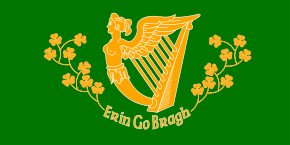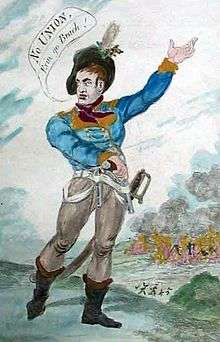Erin go bragh

Erin go Bragh /ˌɛrɪn ɡə ˈbrɑː/, sometimes Erin go Braugh, is the anglicisation of an Irish language phrase, Éirinn go Brách, and is used to express allegiance to Ireland. It is most often translated as "Ireland Forever."[1]
Origin
Erin go Bragh is an English corruption of the phrase Éirinn go Brách in the Irish language.
The standardised spelling in Irish is Éire go Brách, which is pronounced [ˈeːrʲə ɡə brɑːx]. However, Éirinn (which survives as the dative form in the modern standard) is a historic form used instead of Éire in two dialects; this is the source of the anglicised Erin. In all other dialects the distinction between the nominative-accusative Éire and the dative Éirinn is kept distinct. This linguistic shift (dative forms replacing nominative) is common among Irish nouns of the second and fifth declensions.[2]
The term brách is equivalent to "eternity" or "end of time", meaning the phrase may be translated literally as "Ireland until eternity" or "Ireland until the end (of time)". Éire go Bráth (or Éirinn go Bráth) is also used in Irish and means the same thing. Go is a preposition, translatable as to, till/until, up to.
Usage

Emigrant nationalism
In time, the phrase became anglicised. By 1847, it was already in use as "Erin Go Bragh". That year, a group of Irish volunteers, including U.S. Army deserters, joined the Mexican side in the Mexican–American War. These soldiers, known as Los San Patricios or Saint Patrick's Battalion, flew as their standard a green flag with a harp on it, with the motto "Erin Go Bragh" underneath.[3] Variations on this flag design have been used at different times to express Irish nationalism.
In 1862, when a large number of families on the estate of Lord Digby, near Tullamore, County Offaly, were given notice to quit, a local priest, Father Paddy Dunne, arranged passage for 400 people to Australia. A ship was chartered from the Black Ball Line and named the Erin-go-Bragh.[4] The voyage of the Erin-go-Bragh, a "crazy, leaky tub", took 196 days, the longest recorded passage to Australia.[5] A passenger nicknamed the ship the "Erin-go-Slow". It landed in Moreton Bay near Brisbane.[6]
Unionism
At the height of decades of negotiation regarding home rule in Ireland, in the late 19th century the Irish Unionist Party used the slogan on a banner at one of their conventions, expressing their pride in Irish identity.[7]
Sport
In the late 19th century, the Edinburgh football club Hibernian F.C. adopted 'Erin Go Bragh' as their motto[8] and it adorned their shirts accordingly. Founded in 1875 by Edinburgh Irishmen and the local Catholic Church, St Patrick's, the club's shirts included a gold harp set on a green background. The flag can still be seen at a lot of Hibernian matches to this day.
In 1887 a gaelic games club was set up in Clonsilla, Dublin under the name Erin go Bragh GAA. There is also an "Erin go Bragh GAA" club in Warwickshire, England.
In 1906, three Irishmen went to Athens, Greece to compete in the 1906 Intercalated Olympics as an Irish team independent of Britain. They had distinct uniforms and intended to compete for the first time as representatives of their own country. Once in Athens, the Irishmen became aware that the British committee had decided that they would instead compete under the British flag. Peter O'Connor won the silver medal for the long jump. As he was about to receive his medal he rushed towards the flag pole, climbed the pole, and flew the Erin Go Bragh flag, as the Tricolour had not yet received widespread acceptance. The other Irish athletes and a number of Irish-American athletes fended off security for a few minutes while the flag was flown. It was the first time an Irish flag had been flown at a sporting event.[9]
Other uses

- A traditional Scottish song from the 19th century entitled "Erin-go-Bragh" tells the story of a Highland Scot who is mistaken for an Irishman. The first two verses[10] are:
- My name's Duncan Campbell from the shire of Argyll
- I've travelled this country for many's the mile
- I've travelled through Ireland, Scotland and a'
- And the name I go under's bold Erin-go-bragh
- One night in Auld Reekie as I walked down the street
- A saucy big polis I chanced for to meet
- He glowered in my face and he gi'ed me some jaw
- Sayin' "When cam' ye over, bold Erin-go-bragh?"
— 19th Century Scottish song, [11]
- In 1969, the band Wolfe Tones released a song called "Erin Go Bragh" on their LP Rifles of the IRA. The song tells the story of an uprising in Ireland, talking about the courage of the Irish fighters. All 6 verses end with "Erin Go Bragh".
- A version of the traditional Scottish song opens Dick Gaughan's 1981 album Handful of Earth.[12]
- The expression is used by Hercule Poirot in the 1990 television adaptation of Agatha Christie's "The Kidnapped Prime Minister", in which Poirot suspects an Irish connection.
- Andy Irvine also recorded Gaughan's version of this song, with Patrick Street, on their 2007 album On the Fly.
- The expression was paraphrased by a punning New York Times headline Erin go broke, written by economist Paul Krugman, referring to the post-2008 Irish financial crisis.[13]
- In the 2009 film The Boondock Saints II: All Saints Day Norman Reedus's character Murphy MacManus phrases it as: "It's Irish for, 'you're fucked.'"[14]
See also
- Alba gu bràth (Scottish Gaelic cry: "Scotland forever!")
- Faugh A Ballagh (Irish: Fág an Bealach "Clear the way!")
- Tiocfaidh ár lá ("Our day will come!")
- Cymru am byth (Welsh cry "Wales forever!")
References
- ↑ "Encarta MSN Dictionary - "An expression (interjection) meaning Ireland forever"". Archived from the original on 2009-10-31.
- ↑ what is this in Gaelic?
- ↑ "Original Flag" of Batallón de San Patricio The "San-Patricios", "Los Colorados", San Patricio Company
- ↑ Hogan, James Francis (1888). The Irish in Australia. Melbourne: George Robertson & Co. pp. 156–8. Retrieved 22 May 2014.
- ↑ Woolcock, Helen R. (1986). Rights of Passage: Emigration to Australia in the Nineteenth Century. Indiana: Tavistock Publications. p. 55. ISBN 9780422602402. Retrieved 22 May 2014.
- ↑ Hogan (1888), pp. 159, 161
- ↑ Graham Walker (2004). A History of the Ulster Unionist Party: Protest, Pragmastism and Pessimism. Manchester University Press. p. 13. ISBN 0719061091.
- ↑ "Erin go Bragh". Hibernian F.C. 11 August 2009. Retrieved 15 January 2011.
- ↑ urbsintacta (2013-05-21), 1906, Peter O'Connor and the 1906 Olympics, retrieved 2016-09-11
- ↑ "Erin-go-Bragh" (19th century Scottish song)
- ↑ Cran, Angela; Robertson, James (1996). Dictionary of Scottish Quotations. Mainstream. p. 336. ISBN 1-85158-812-4.
- ↑ "Handful of Earth". Topic Records current catalogue. Topic Records. Retrieved 10 August 2011.
- ↑ Krugman article, April 2009
- ↑ Memorable quotes for The Boondock Saints II: All Saints Day
External links
- What does 'Erin go braugh' mean? (FAQ Farm)